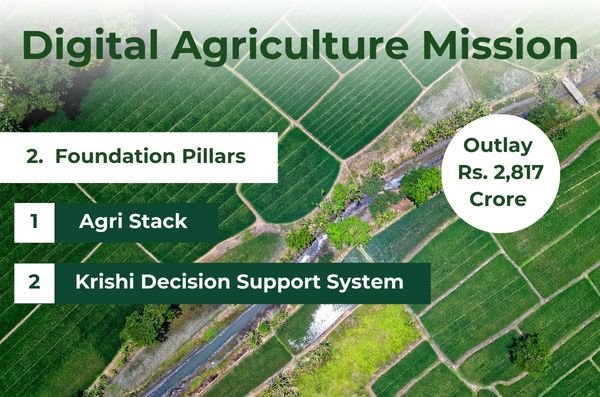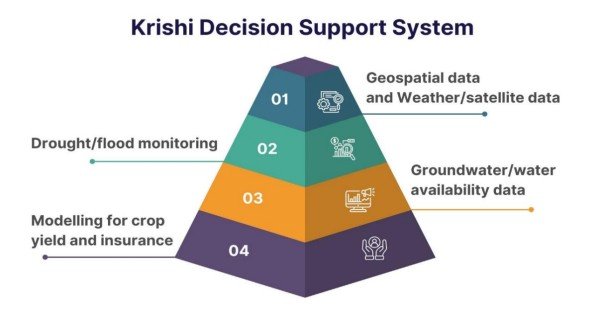
Recently India approved the Digital Agriculture Mission with an outlay of Rs. 2,817 Crore for transformation of the agriculture sector.
The Digital Agriculture Mission is an umbrella scheme to support various digital agriculture initiatives.
These include creating Digital Public Infrastructure (DPI), Implementing the Digital General Crop Estimation Survey(DGCES), and supporting IT initiatives by the central government, state government, academic and research institutions.
There are two foundation pillars of the scheme namely ‘Agri Stack’ and ‘Krishi Decision Support System’.
Agri Stack: Kisan Ki Pehchaan
It is designed as a former-centric Digital Public Infrastructure (DPI) to streamline services and scheme delivery to farmers. It comprises of three components namely Formers Registry, Geo-referenced village maps and Crops Sown Registry.
It has introduced ‘Former ID’, which is similar to Aadhaar card, serving as a trusted digital identity for the formers. These IDs will be linked with former-related data including land records, livestock ownership, crops sown and benefits availed.
In Addition, the mission includes ‘Soil Profile Mapping’ and aims to enable former-centric digital services to provide timely and reliable information for the agriculture sector.
Pilot projects have been conducted in six states including Uttar Pradesh(UP), Gujarat, Maharashtra, Haryana, Punjab, and Tamil Nadu.
Agri Stack is launching the Digital Crop Survey nationwide within 2 years, covering 400 districts in FY- 2024-25 and all districts in FY 2025-26.
Krishi Decision Support System
The Krishi Decision Support System (DSS) will integrate remote sensing data on crops, soil, weather, and water resources into a comprehensive geospatial system.

Soil Profile Mapping
- It will provide Soil Profile Maps on a 1:10,000 scale for approximately 142 million hectares of the country’s agricultural land, 29 million hectares of soil profile inventory already being mapped.
- The Digital General Crop Estimation Survey (DGCES) will provide yield estimates based on scientifically designed crop-cutting experiments
- It would create Employment opportunities to about 2.5 lakh trained local youth and Krishi Sakhis
- The digital drop surveys, collection of ground-truthed data for remote sensing will be provided
What are the Benefits of the Mission?
- Digital authentication for accessing services and benefits, reducing paperwork and the need for Physical visits
- Enhanced efficiency and transparency in government schemes, crop insurance and loan systems through accurate data on crop area and yield
- Crop map generation and monitoring for better disaster response and insurance claims
- Development of digital infrastructure to optimize value chains and provide tailored advisory services for crop planning, health, pest management, and irrigation.
The Union cabinet also approved 6 major schemes alongside the Digital Agriculture Mission with a total outlay of Rs. 14,235.30 Crore.
These initiatives include Rs 3,979 Crore for crop science aimed at ensuring food security and climate resilience by 2047, and Rs. 2,291 Crore for strengthening agricultural education, management, and social sciences to support students and researchers.
Rs. 1,702 Crore is allocated for sustainable livestock health and production to boost incomes from livestock and dairy, while Rs. 1,129.30 Crore is designated for sustainable development for horticulture to increase income from horticulture.
Additionally, Rs. 1,202 Crore will be invested in strengthening Krishi Vigyan Kendra, and Rs. 1,115 Crore towards Natural Resource Management.
